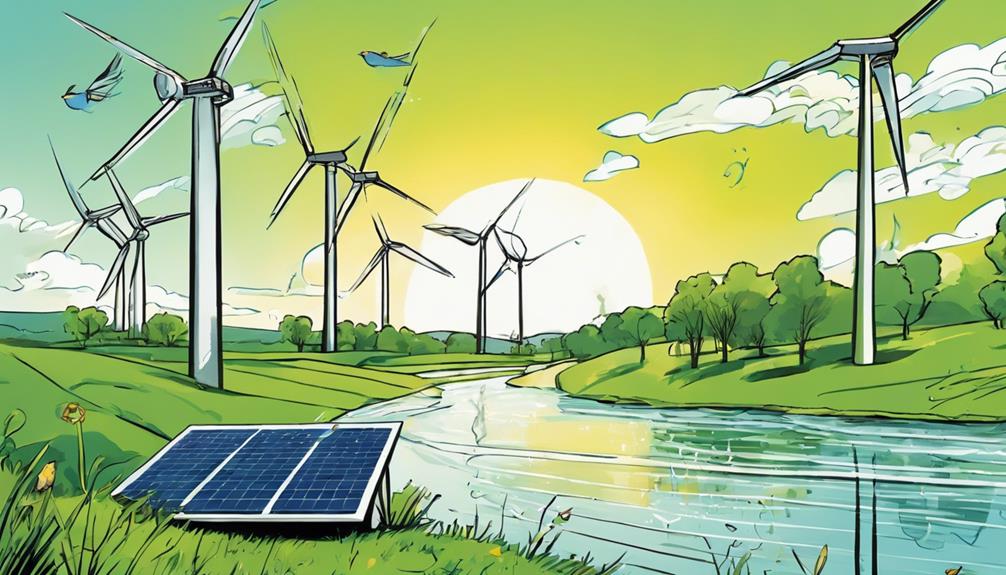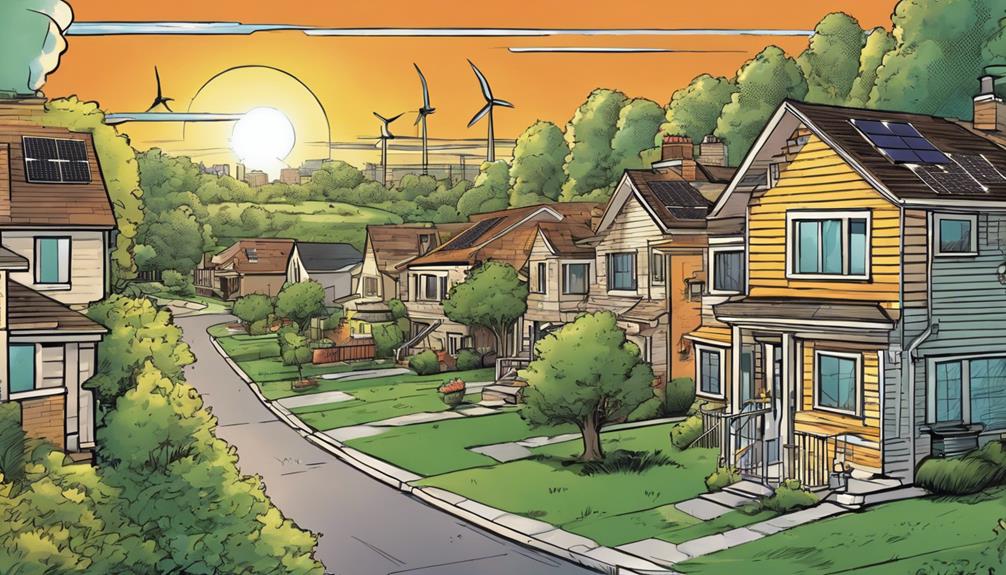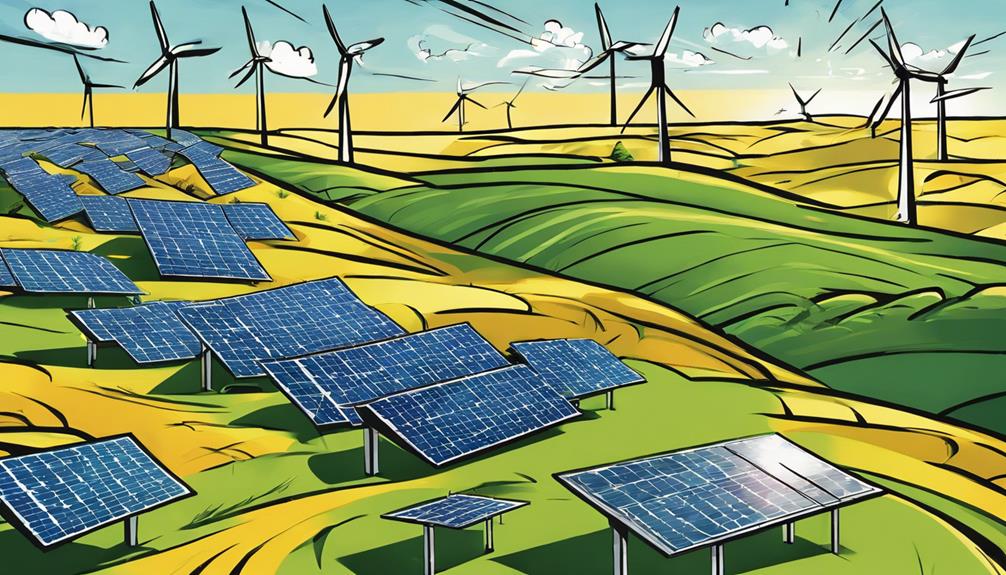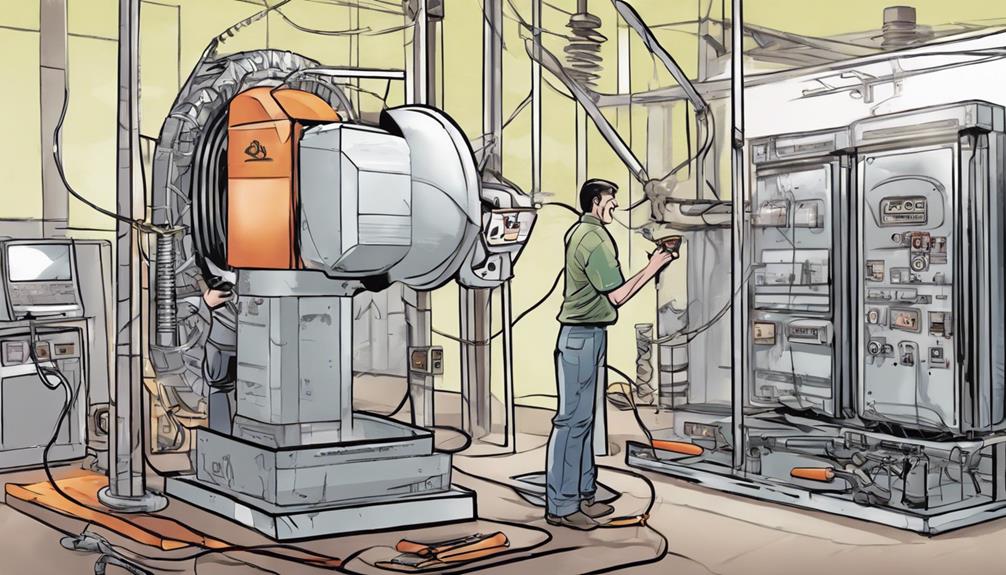When deciding between solar and wind energy, consider that wind turbines convert 60%-90% of wind energy, while solar panels can transform up to 20% of sunlight into electricity. Each has distinct advantages based on efficiency and application. Wind power tends to excel at larger utility-scale projects, while solar energy is more practical for residential settings. Both options are eco-friendly, emitting zero carbon and supporting efforts to combat climate change. To get a complete view of the efficiency and benefits of solar vs. wind, explore how they compare regarding cost-effectiveness, environmental impact, and future trends.
Key Takeaways
- Wind turbines have a higher energy yield than solar panels.
- Solar panels are more practical for residential use.
- Both solar and wind energy are emission-free and combat climate change.
- Solar panels generally have lower maintenance costs than wind turbines.
- Wind power is more economical at a utility-scale level.
Efficiency of Solar Vs. Wind
When comparing the efficiency of solar energy to wind energy, wind turbines have a higher energy yield, converting between 60% – 90% of energy from wind, while solar panels can convert up to 20% of energy from the sun into electricity. This difference in energy conversion rates highlights the advantage wind power holds over solar in terms of efficacy.
Wind energy, with its superior energy yield, proves to be more practical at a utility-scale level due to its higher conversion rates. On the other hand, solar panels are more suited for residential use, providing a convenient and accessible option for individual homeowners looking to generate electricity sustainably.
The comparison between wind and solar in terms of efficiency clearly showcases the strengths of each technology, with wind leading the way in overall energy conversion rates, making it a formidable contender in the renewable energy sector.
Environmental Impact Analysis

Solar power and wind energy have a positive environmental impact due to their emission-free operation and contribution to reducing carbon emissions. These renewable sources of clean energy play an important role in combating climate change by significantly reducing the release of greenhouse gases into the atmosphere.
One of the benefits of both solar and wind energy is their minimal land use compared to traditional fossil fuel power plants. Additionally, wildlife impact studies are conducted to make sure that the installation and operation of solar panels and wind turbines have minimal negative effects on local ecosystems.
Cost Effectiveness Comparison

Considering the cost efficiency of solar and wind energy is vital in determining the most suitable renewable energy option for your specific energy needs and location. Solar panels generally have lower maintenance costs than wind turbines, making solar energy more cost-effective for residential use. A 10 kW PV solar system costs around $24,900 before tax credits, while a 10 kW wind turbine can reach $75,000 before tax credits.
Solar energy is considered more economical and practical for residential applications, while wind power excels at utility-scale levels. The financial benefits of each renewable source depend on factors like installation location, energy needs, and available resources. Combining solar and wind energy can lead to savings on electricity costs and contribute to a more sustainable future.
Evaluating the cost efficiency of solar and wind energy in relation to your energy requirements and installation location is essential for maximizing the financial advantages of these renewable sources.
Residential Applications Evaluation

In evaluating residential applications for renewable energy sources, the efficiency and practicality of solar panels and wind turbines play a significant role.
When considering these options, here are some key points to keep in mind:
- Efficiency: Residential solar panels are typically around 20% efficient in converting sunlight into electricity, while wind turbines have shown increased efficiency over the years.
- Cost: Installing a solar array with 10-30 panels can cost between $20,000 to $40,000, offering long-term savings on electricity bills.
- Energy Independence: Both solar panels and wind turbines provide opportunities for energy independence, whether through grid-tied systems or off-grid applications.
- Savings: Investing in renewable energy sources like residential solar panels or wind turbines can help save money in the long run and contribute to a more sustainable lifestyle.
Considering these factors, residential applications of solar panels and wind turbines present viable options for those looking to generate power, save money, and reduce their carbon footprint.
Future Outlook and Trends

Looking ahead, advancements in technology are expected to drive increased efficiency and cost-effectiveness in renewable energy sources like solar and wind power. The future outlook for solar energy includes enhanced efficiency through technological advancements, making it a more attractive option for energy generation.
In addition, wind power trends indicate a shift towards offshore wind farms, offering higher energy generation potential compared to onshore installations. Both solar and wind energy are projected to become more cost-effective over time, making them competitive alternatives to traditional fossil fuels.
Innovations in energy storage solutions are also on the rise, improving the reliability of solar and wind power by enabling energy capture and distribution during periods of low generation. Moreover, the trend towards decentralized energy generation supports the widespread adoption of both solar and wind energy sources, empowering communities to become more self-sufficient in meeting their energy needs.
These advancements signal a promising future for renewable energy as key players work towards a more sustainable and efficient energy landscape.
Frequently Asked Questions
What Is More Efficient, Wind or Solar Energy?
When comparing energy efficiency, wind turbines outperform solar panels, converting a higher percentage of energy. Wind energy offers higher yield, making it a preferable option for utility-scale electricity generation. Opt for wind for efficiency.
What Is One Advantage Wind Power Has Over Solar Power?
One advantage wind power has over solar power is its ability to generate electricity around the clock. Harnessing wind energy guarantees a continuous power supply, making it a reliable option for meeting energy demands consistently.
How Many Solar Panels Equal One Wind Turbine?
To match the energy from one wind turbine, you'd need thousands of solar panels. Wind turbines are more efficient in converting wind energy to electricity, with a single turbine outperforming numerous solar panels in energy yield.
Is Solar or Wind a Better Way to Power Your Home?
When powering your home, consider solar for easy installation and cost-effectiveness, or wind for continuous power generation. Both have benefits, so choose based on your location and energy needs. Evaluate efficiency and benefits for your specific situation.
How Do Advancements in Solar Cell Efficiency Compare to the Benefits of Wind Energy?
The advancements in solar cell efficiency have made solar energy more competitive with wind energy. As solar technology improves, it is becoming an increasingly viable alternative to traditional forms of energy production. However, the benefits of wind energy, such as its predictability and low environmental impact, still make it a valuable option for renewable energy.
Conclusion
So, there you have it – solar vs. wind. Sure, wind might be a bit breezier, but when it comes to efficiency and benefits, solar shines brighter.
Don't get blown away by the hype, go with the power of the sun. It's not just a phase, it's the future. Embrace the solar revolution and leave the wind in the dust.
The choice is clear – sunny days ahead!










